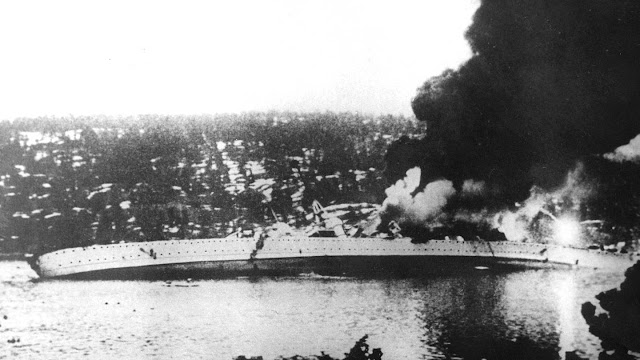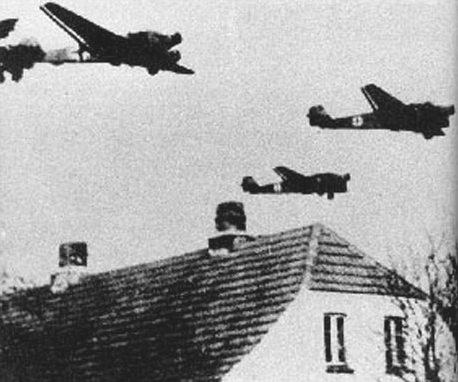Tuesday 9 April 1940
 |
| Kriegsmarine cruiser Blucher after the engagement at the Oscarsborg Narrows. |
Prior to the invasion of Norway and Denmark, there had been secret peace talks conducted through the Vatican. While little known, and contingent upon removal of Adolf Hitler from power, they may have borne fruit. After the invasion, however, those talks ended. Peace based on the status quo ante became impossible.
Operation Weserubung was the decisive moment in the chain of events which led to the Soviet conquest of Berlin. The Phony War may have died a quiet death if neither side had launched a major attack on the other. After this, each link in the chain also could have been broken, but it became progressively harder as each side became hardened in its position. Norway and Denmark also were the last two virtually untouched portions of the Nazi Reich when the war ended.
Operation Weserubung: The Germans land in Norway and Denmark. It is River Weser Day in Germany, and thus an appropriate date for a River Weser Exercise. At 05:20, the Germans deliver a diplomatic memorandum to each government stating that they now will be under the Reich's protection for the duration.
For the time being, the existing government of Denmark will be permitted to remain in power. Norwegian Foreign Affairs Minister Halvdan Koht, however, responds with the defiant words "Vi gir oss ikke frivillig, kampen er allerede i gang" ("We will not submit voluntarily; the struggle is already underway"). The Norwegian government does not capitulate like Denmark and instead heads for the mountains in the north. They somewhat awkwardly order full military mobilization for 11 April 1940. This is done by post, so it takes a minimum of two days.
 |
| Norwegians fleeing during the invasion. PHOTO: SCANPIX / SCANPIX |
Weserübung Nord (Norway): German transports which have been collecting offshore land at Oslo, Kristiansand, Stavanger, Bergen, Trondheim and Narvik.
Outside Oslo, German Bf-10 fighters land at Fornebu Airfield, followed by Ju-52 transports carrying a battalion of 324th Infantry Regiment of German 163rd Infantry Division. They are quickly followed by units of 324th Infantry Regiment of German 163rd Infantry Division and two companies of 1st Fallschirmjaeger Regiments. The German embassy at Oslo sends a welcoming party to the waterfront.
The battle at Oscarsborg Fortress downstream from Oslo is known as the Battle of Drøbak Sound. It begins at 04:21 when the Kriegsmarine force approaches, and at first in the darkness, the Norwegians don't know who it is or whether they should fire. Their commander, Col. Eriksen, yells: "Either I will be decorated, or I will be court-martialed. Fire!" The fortress' guns include 19th Century cannon "Moses" and "Aaron," but they are as lethal as modern cannon.
Here, at the Oscarsborg Narrows in the Oslo Fjord, the coastal batteries manned by elderly reservists sink the Kriegsmarine cruiser, Blücher, in Oslo Fjord (830 perish, 1370 swim ashore) using guns and fixed torpedo mounts.
This action enables the Norwegian government and its gold reserves to escape - they leave at 08:30. The brand new cruiser, however, is a significant loss. Torpedo boat Albatros also is damaged. Elements of 324th Infantry Regiment of German 163rd Infantry Division land outside Oslo, led by Kriegsmarine heavy cruiser Lutzow.
Airborne troops capture Fornebu Airport (Oslo) and Stavanger-Sola airfield. This gives Luftwaffe protection over the most vulnerable sectors of the invasion. Battalions of the 193rd Infantry Regiment of the German 69th Infantry Division are airlifted into Sola and Stavanger.
At Narvik, the most strategic location in Norway because it is where the Swedish iron ore is shipped, German destroyers Wilhelm Heidkamp and Bernd von Arnim elude heavy British patrols due to the weather and sheer luck. They burst into Narvik Fjord, sink Norwegian coastal protection ships Eidsvold and Norge, and land their troops.
At Bergen, Kvarven Fort’s batteries damage cruiser Königsberg and minelayer Bremse.
At Kristiansand, morning fog delays the landing. Stavanger airport is taken despite a Norwegian destroyer sinking a ship with the airborne force's equipment. At Bergen, cruiser Konigsberg is damaged by a coastal battery, but the troops get ashore. The British react quickly and send a destroyer force to retake the city.
Trondheim falls without a shot after the German ships sail past the coast defense batteries pretending to be British. Detachments of soldiers land at Arendal and Egersund and capture the cable stations there.
Norwegian coastal artillery sinks German cargo liner Seattle.
Norwegians scuttle destroyer Tor at Fredrikstad, but it is in a location where the Germans can recover it.
King Haakon and Prime Minister Nygaardsvold elude German capture after the Norwegian garrison is betrayed by Colonel Sundio.
The Norwegian gold reserve leaves Oslo in the morning. It is in 818 cases weighing 40 kilos each, 685 cases weighing 25 cases each, and 39 kegs weighing 80 kilos each. The shipment totals 53 tonnes, of which the gold itself weighs 48.8 tonnes.
Vidkun Quisling using Oslo Radio proclaims himself Prime Minister, tells Norwegians to cease resistance, and, quite accurately (but perhaps leaving out a word or two) states: "I shall be called the big traitor." He is completely ignored.
 |
| Junkers Ju 52 transport aircraft flying over Copenhagen on the morning of 9 April 1940. |
Some Danish islands are occupied. Paratroopers drop at Vordingborg on Zealand and capture Storstrom bridge. Elements of German 198th Infantry Division land on Funen Island, securing the bridge from Jutland and the ferry crossing to Zealand
A battalion of German 308th Infantry Regiment lands by ship in Copenhagen. They simply sail up to the Copenhagen waterfront and disembark. The only resistance in Copenhagen is one policeman with a pistol. The Danish King can hear scattered gunfire as he meets with his ministers and General Pryor.
German paratroopers drop and capture Alborg airfield in northern Jutland.
German troops land by ship at Tyboron and Esbjerg.
 |
| Danish soldiers in position on the outskirts of Aabenraa in the morning of April 9, 1940. Photo: Th. Chris thesis. |
Luftwaffe Bf 110 fighters attack Vaerlose Airfield, the Danish Air Force headquarters. One Danish fighter is shot down. Luftwaffe He 111 bombers drop leaflets over Copenhagen and instruct residents what to do. The Danish Navy remains at anchor.
Danish Prime Minister Thorvald Stauning orders cessation of hostilities twelve hours after the start of the invasion. Even by then, however, the situation is completely stabilized and the country pacified. King Christian is nonplussed: "General, may I tell you something? As 1 soldier to another? You Germans have done the incredible again- magnificent work!" General Himer, the German captor of the city, notes, however, that the king is "inwardly shattered."
Overall, despite more shipping losses than the Kriegsmarine would like, Operation Weserübung is a resounding success on its first day.
Battle of the Atlantic: The British Home Fleet, having headed into the Atlantic based upon a false assumption that the Kriegsmarine was headed there, turns and heads toward Bergen. By the time it approaches at 14:00, the Luftwaffe is operating at airfields within Norway. Attacks by 47 Junkers Ju 88s and 41 Heinkel He 111s damage the Battleship Rodney (a 500 kg bomb hits but does not explode), three cruisers, and sink the destroyer HMS Gurkha (15 perish). Four of the Ju 88s are shot down.
The Germans capture numerous Norwegian vessels. These include:
- coast defense ship Harald Haarfagre captured by German forces at Horten
- coast defense ship Tordenskjold captured by German forces at Horten
- torpedo boat Balder captured by German forces at Horten
- minelayer Olav Tryggvason captured by German forces at Horten
- torpedo boat Odin captured by German forces at Marvika
- torpedo boat Gyller captured by German forces at Marvika
- submarine B-5
The Norwegians scuttle torpedo boat Tor off Frederikstad.
At 19:57, British submarine HMS Truant torpedoes and damages light cruiser Karlsruhe in the Skagerrak as it is returning from Kristiansand. German E-boats finish it off at 21:50 to avoid capture.
British submarine HMS Thistle fires four torpedoes at U-4 as it approaches Stavanger, but misses with all four.
British submarine HMS Sunfish sinks German cargo Amasis in the Skagerrak.
French submarine Sybille departs from Harwich to patrol west of Denmark.
Convoy OA 126 departs from Southend, Convoy OB 126 departs from Liverpool.
Allied Supreme War Council: Daladier, General Gamelin, and Admiral Darlan fly to London for consultations. Some of what they discuss is information they learn from the early edition of the New York Times.
British Military: The War Cabinet decides to occupy the Faeroe Islands and offer "assistance" to Iceland.
US Military: The Joint Planning Committee issues a general assessment of the world situation - which, due to events in Scandinavia, is immediately outdated. "Rainbow plans" which designate potential enemies by colors are submitted which envision multiple attacks from several different adversaries simultaneously.
Sweden: The German ambassador informs the Swedish government that it will not be invaded. However, it must remain neutral, maintain communications systems linking Norway and Germany, and must continue delivering iron ore to the Reich.
British Homefront: There are 212,000 children in London, and the government is trying to get them to safer locales. Only 20% of parents respond to that request, and authorities blame "parental apathy."
American Homefront: A Gallup survey finds that 84% of Americans want the Allies to win, 2% want the Germans to win, and only 23% actually want to fight the war.
 |
| German troops entering Copenhagen. |
April 1940
April 1, 1940: Weserubung is a GoApril 2, 1940: British Subs On Alert
April 3, 1940: Churchill Consolidates Power
April 4, 1940: Missed the Bus
April 5, 1940: Mig-1 First Flight
April 6, 1940: Troops Sailing to Norway
April 7, 1940: Fleets At Sea
April 8, 1940: HMS Glowworm and Admiral Hipper
April 9, 1940: Invasion of Norway
April 10, 1940: First Battle of Narvik
April 11, 1940: Britain Takes the Faroes
April 12, 1940: Germans Consolidate in Norway
April 13, 1940: 2d Battle of Narvik
April 14, 1940: Battle of Dombås
April 15, 1940: British in Norway
April 16, 1940: Germans Cut Norway in Half
April 17, 1940: Trondheim the Target
April 18, 1940: Norway Declares War
April 19, 1940: Dombås Battle Ends
April 20, 1940: Germans Advancing in Norway
April 21, 1940: First US Military Casualty
April 22, 1940: First British Military Contact with Germans
April 23, 1940: British Retreating in Norway
April 24, 1940: British Bombard Narvik
April 25, 1940: Norwegian Air Battles
April 26, 1940: Norwegian Gold
April 27, 1940: Allies to Evacuate Norway
April 28, 1940: Prepared Piano
April 29, 1940: British at Bodo
April 30, 1940: Clacton-on-Sea Heinkel
2020
No comments:
Post a Comment